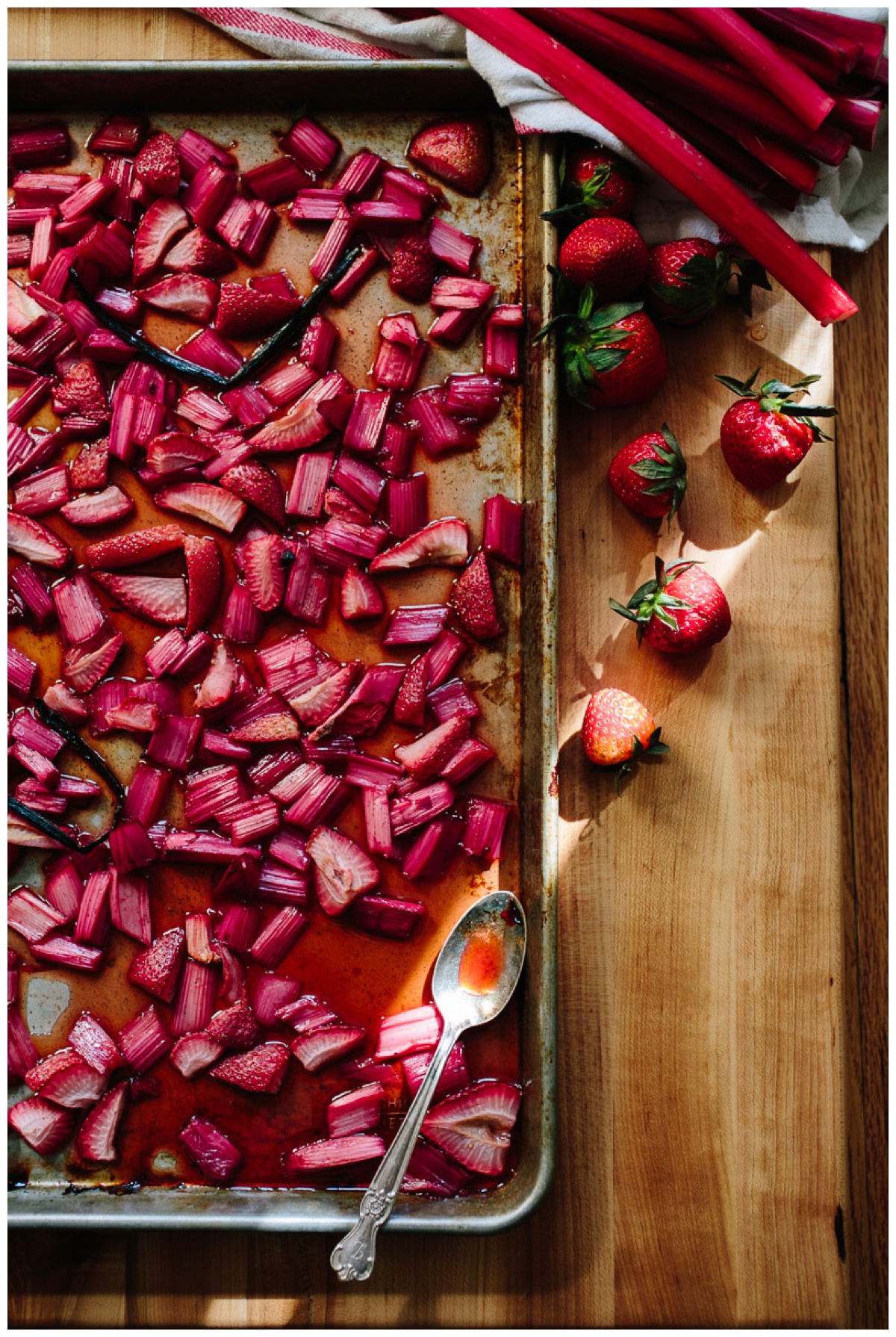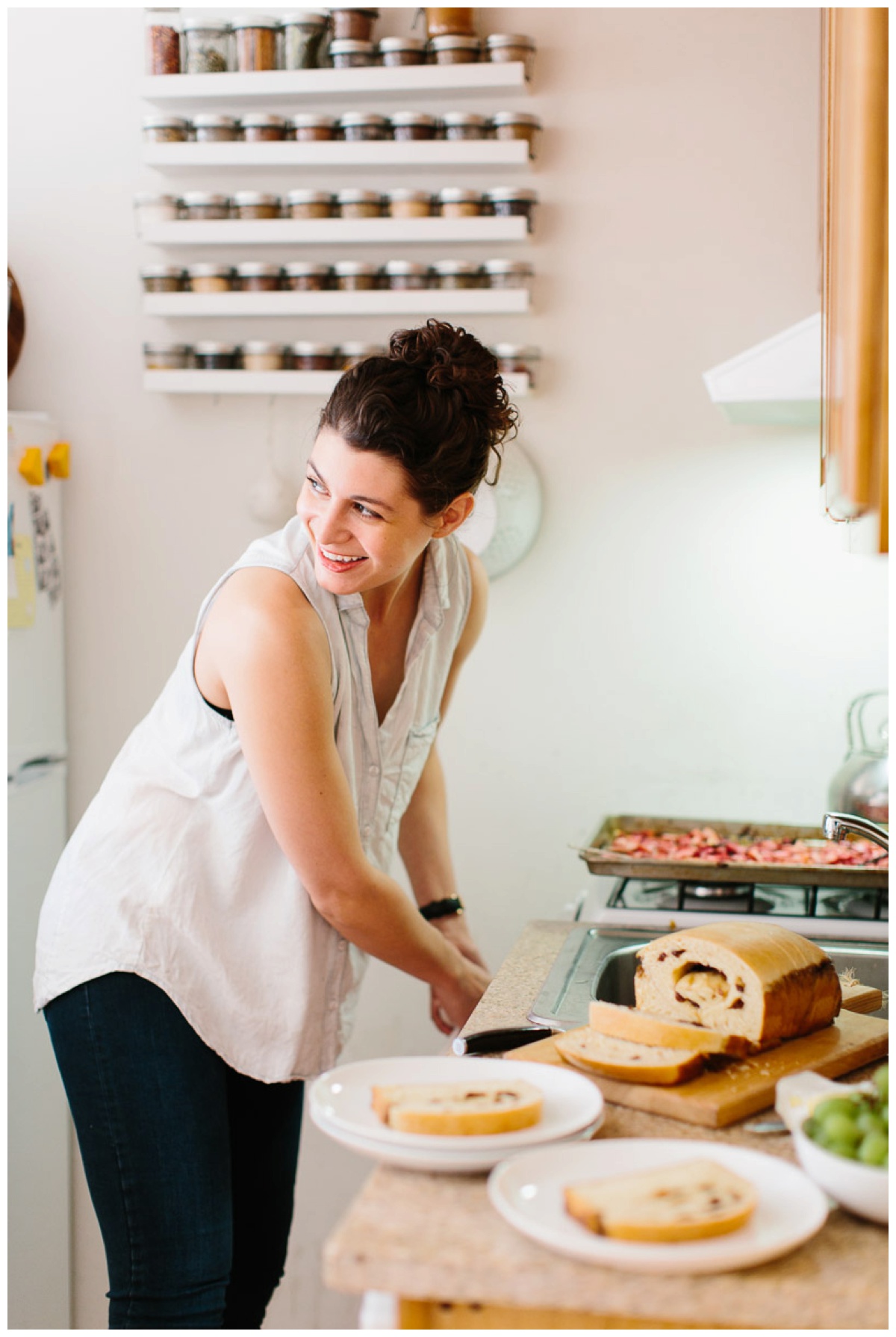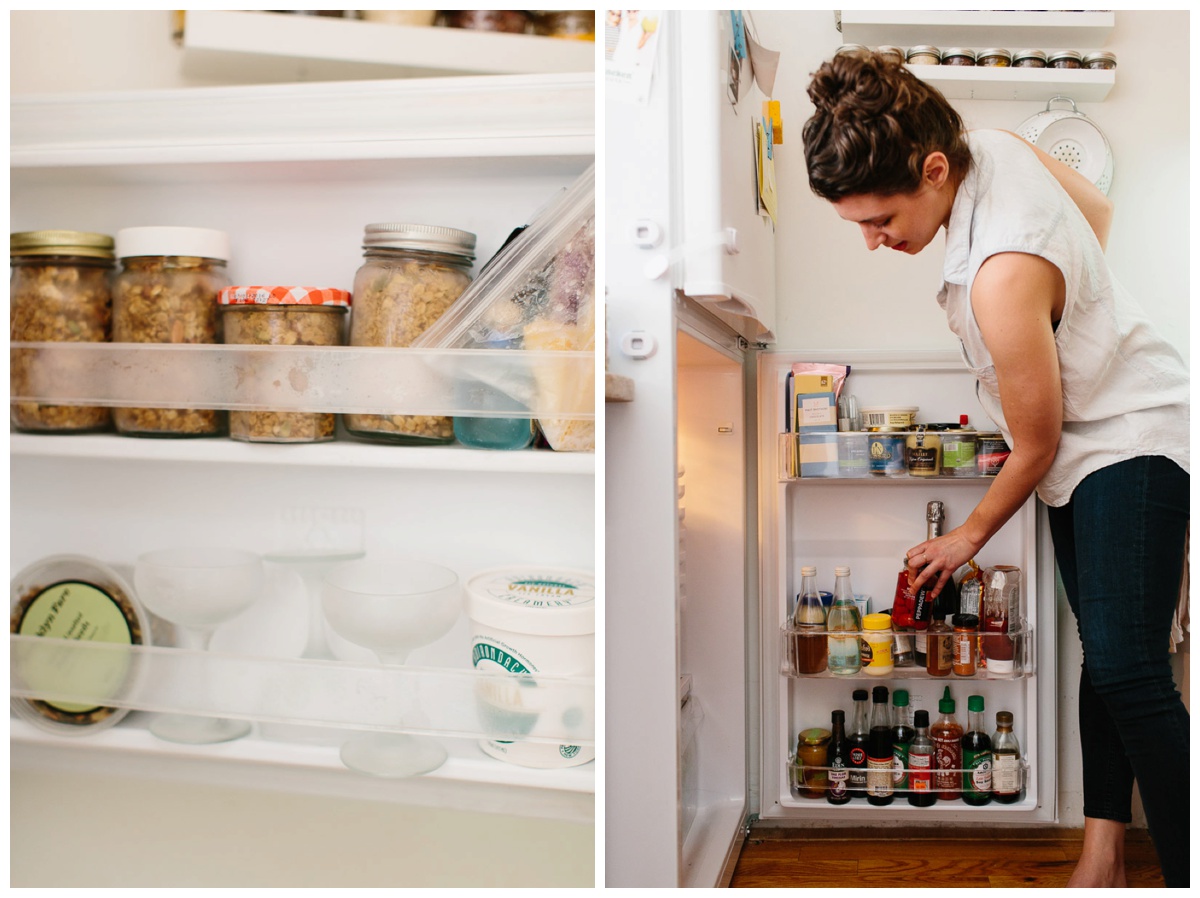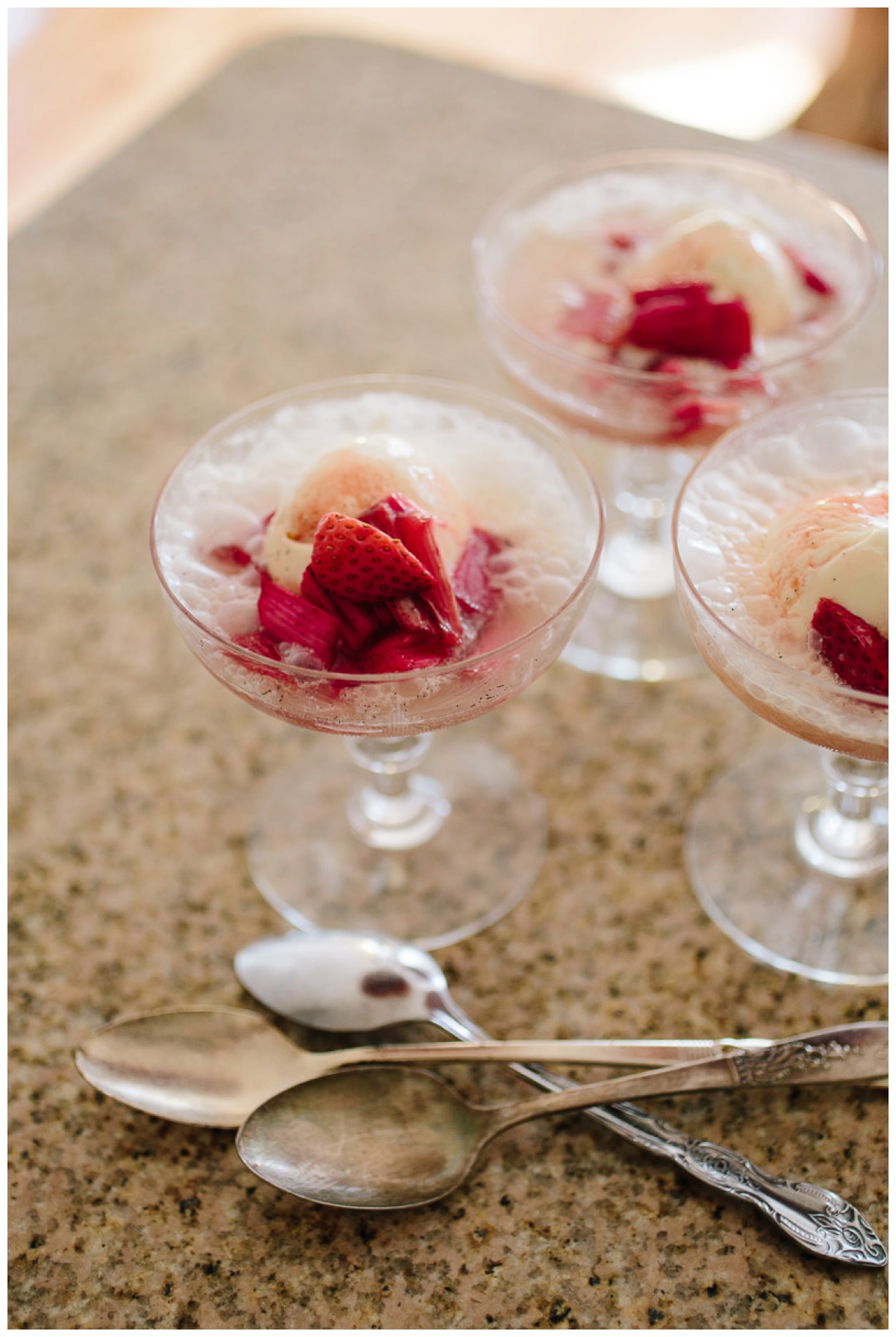Photos by Christine Han Photography for Pantry Confidential.
Rebekah Peppler, Food Stylist, Writer, Recipe Developer
Oh, Rebekah! This is the type of person you can while away an entire afternoon with. A midwestern gal with Wisco roots (and proud of it!), she’s happiest talking about summer sausage and singing the virtues of the oft-misrepresented 7-layer salad (have you heard of either?). Rebekah’s down-to-earth demeanor belies her fancy classically-trained pastry chef background and Type A-when-it-comes-to-work personality, but it’s this ability to maintain balance so effortlessly while giving everything a just-so finishing touch that makes her the popular food stylist she is. She works hard, parties harder, and makes everything look like a breeze in the process—that’s when you know you’re dealing with a pro.
Read on to learn what surprising ingredient Rebekah tries to incorporate into much of her baking and get your hands on a KILLER Negroni rhubarb float recipe—AND! A chance to win her Short Stack Editions: Honey cookbook!
Hi Rebekah! Please tell us a little bit about yourself and what you do as a food stylist. Can you share with us the road you took to get to where you are today?
I studied journalism and art history in college back in Wisconsin then moved to New York City to study pastry arts at the French Culinary Institute. I always knew I wanted to combine my love of words, food and beauty in one place. Food styling and writing are two incredible channels to do so.
I’ve found that the job of a food stylist is very often glorified into this epic dream gig. Don’t get me wrong, it totally is. But it’s not just hanging out on set with tweezers and spray bottles making food look gorgeous. The thing most people don’t know about food styling is the vast disparity between time in the kitchen and time on set. I spend 90 percent of my time sourcing, shopping, schlepping, prepping and cooking the food and about 10 percent playing with the food on camera. All that "preliminary" work leads to the perfect final shot, not just the fun Dexter tools.
How did your Honey Short Stack book come about?
I've known and worked with the team behind Short Stacks for years now and consider them both friends and colleagues, a combination that always make for crazy fun collaborations. I remember when the idea behind the publication was just a twinkle in the publisher Nick's eye and I told him once he made it happen, I was in. Once Short Stacks came to fruition, he called me up, asked which ingredient I wanted and it snowballed from there. I’m lucky I claimed honey, it’s such an incredible ingredient to play with.
Please walk us through a “typical” project. How exactly do you develop a recipe? Many people don’t know what goes into creating one, especially all the unseen labor that goes into simply procuring and preparing the ingredients.
Since I’m not sure a “typical” shoot exists, I’ll walk you through a stand-alone recipe. When I’m developing recipes they’re normally for either a magazine, online publication or a cookbook. First, a client reaches out with an idea of what they need, say 10 easy fall recipes for a food magazine. We work out the contract (rate, deadline, etc.), then I come back to them with one to two sentences on each recipe detailing the range of ingredients, what method I’m planning on using and anything else that might interest them. They come back to me and say, your ideas are perfect, go develop! I write up full drafts for each recipe (littered with “TK"s to fill when I’m in the kitchen), run to the store(s), shop all the ingredients and hop in the kitchen. Depending on the recipe, I'll test it two to four times to get it just right, sometimes more if it's finicky. Then I'm on my computer filling in the TK’s and adding any changes I made along the way. I also make sure each recipe is written in the style of the publication (everybody has their own quirks). I send the finished recipes out with my invoice and log all the details into my personal accounting sheet for the year (freelance is all about organization--I don't know what I'd do without Excel and Moleskin notebooks). If all goes well, I’ll eventually see the recipes in print, send a copy to my mom and et voilà! A recipe.
How would you describe your cooking style + food aesthetic? Where do you draw inspiration from?
While I'm all for sampling the newest thing to enter the food world, when I'm in my home kitchen it's all about the classics with a twist. I grew up in the Midwest (Oshkosh, Wisconsin) and in a kitchen brimming with hearty, locally-sourced ingredients. To me, cooking at home isn't so much about technical skill or crazy ingredients but rather--as hokey as it sounds--the heart you put into it. My heart happens to have a particular fondness for dairy.
What do you like to make for yourself after a full day of cooking for others?
Does a glass of wine count? Honestly, after a completely packed day surrounded by food on set I can usually be found on the couch with a wine glass in one hand and a hunk of cheese in the other. Bonus points for also taking the time to pull out crackers and olives but don't count on it.
What do you love most about your kitchen?
My kitchen is petite but has epic (compared to what I've had in the past) counter space. I put two stools on the opposite edge of the middle island and have spent many afternoons force feeding friends/getting them tipsy while I test recipes on the other side. It also boasts a (modest 20-inch) gas stove (especially dreamy as I suffered through electric in many of my past apartments) and (a first in my seven years in NYC) a dishwasher.
Also, since the apartment is south-facing, it's flooded with light all day long which makes for particularly lovely prep and writing days (and even more delightful fire escape cocktail hours). Plus, the dainty size of the space has really allowed my Type A tendencies to blossom, forcing me to be extra creative with storage: I have one drawer and four narrow cabinets all day to work with and I can say with a happy heart that the only thing that is relegated to the (apartment's only) closet is the ice cream maker. If that’s not a win, I don’t know what is.
Where do you shop for kitchen supplies?
Honestly, for such a tiny space (my apartment has a single closet), I have a completely stocked kitchen. I’m still holding out for a Vitamix but otherwise I can’t fit another thing in. If I need something for a shoot it’s NY Cake and Bake in the city, A Cook’s Companion on Atlantic in Brooklyn or I’ll hop on Amazon Prime.
More often, I’m shopping for ingredients and there's plenty of places I love: Kalustyan’s, Sahadi’s and Dual Specialty Store for spices and dry goods. I’m constantly at Whole Foods, Fairway and Union Market. Plus there’s a deli down the street from me that has the craziest stuff; I’m always in there.
Favorite utensils to use at home?
A fish spatula and a Microplane. They're in constant rotation.
Top pantry essentials in your kitchen?
I have an over-stocked pantry due to all the recipe testing I do, but personal essentials include whole coffee beans, honey, good crackers and always, always gummy candies.
Do you have a secret ingredient you love to use?
It’s not a really secret or a surprise if you’ve ever worked with me but I absolutely love malted milk powder. The, I’d-bring-it-to-the-desert-island-with-me, kind of love. You give me free reign and 9 times out of 10 I’ll put either that or poppy seeds into a recipe. I also end up putting a ton of booze in recipes. My bar, conveniently located next to both my kitchen and my bed (a perk of living in a teeny apartment!), is nicely stocked and never fails to provide inspiration. Sometimes I’ll just buy an interesting spirit not so much for the cocktails I can make with it but what I imagine I’ll dream up in the kitchen with it.
I’ve also recently started playing with powdered milk. Like the kind you get in the bag for a ridiculously cheap price. I’m trying to figure out how to make a cookie I used to eat as a kid and I’m convinced the secret lies in that bag of Carnation instant.
Guilty pleasure ingredient or dish?
Seven layer salad. If you're not from Wisconsin you may not know what this is but, basically, fill a casserole dish with (in this order) a layer of lettuce, chopped bell peppers, red onion, celery, mayonnaise, sharp cheddar cheese and bacon and you have the dish I eat as soon as I land on home soil. I just got back from a trip home and, no joke, I ate it once a day… mostly for breakfast. So far, no one I've met in NYC (or anywhere outside my home town) gets the allure but I'm working diligently on changing that.
CHEEZ DRAWER.
Who are the chefs and food producers you admire?
There are so many people in food to admire right now and I’m so darn fortunate to work with a lot of them. I’ll keep it short and personal: Melissa Clark is a dream to work with and her recipes are always spot on. I was cooking her recipes way before we met and find myself even more enamored with them—and her—the longer we work together. Same goes for my assistants, Jade Zimmerman and Adelaide Mueller. Those woman can cook and they make me look better than I could ever make myself. Lauren Deen for taking a chance on me so many, many years ago and pretty much throwing me into the start of my food styling career. And, oh, my grandma for pretty much everything. She still grows and picks her own raspberries and knows how to make a pie with them that will make you weep.
Favorite cookbooks, blogs and sites?
Anything by Dorie Greenspan. I spent most of college baking from her books and she never steered me wrong. Same goes for Julia (Child).
Whose pantry would you like to raid?
Does everyone read that as panty raid at first? For the pantry, I’d raid my mom’s. She has the most meticulously organized and perfectly stocked pantry. It’s insane and I’m never happier than when I’m cooking in her kitchen. I’d also raid Bon Appetit's, because their test kitchen manager Brad keeps that place stocked to a T.
As for a panty raid, she’s going kill me for saying this but I’d totally raid my close girlfriend Erin Hartigan’s… she knows why. (Sorry, E.)
* * *
Negroni-Rhubarb Floats
Courtesy Rebekah Peppler
Makes about 2 cups
1 pound rhubarb, sliced into 1-inch pieces
½ pound strawberries, hulled and quartered
6 tablespoons granulated sugar
3 ounces Campari
3 ounces gin
2 ounces vermouth
1 vanilla bean, split and scraped
1 orange peel ¼ teaspoon kosher salt
Vanilla ice cream
Champagne or sparkling wine
Preheat the oven to 400°F.
In a medium bowl, combine the rhubarb, strawberries, sugar, Campari, gin, vermouth, vanilla bean and seeds, orange peel and salt. Toss to combine and dissolve the sugar. Spread on a baking sheet in an even layer and roast until the rhubarb and strawberries are soft and jammy, 10 to 15 minutes. Set aside to cool.
To serve, scoop vanilla ice cream into chilled coupe glasses. Top with a generous spoonful of the roasted rhubarb mixture and a hefty splash of champagne. Serve immediately.
Thank you for opening your home to us! Stay updated with Rebekah and her delectable creations on social media:
Rebekah Peppler | Instagram
For your chance to win a copy of Rebekah's Short Stack book, Honey, please leave a comment below. You have until Friday, August 14, 11:59pm/EST, to enter. Winner will be chosen at random - good luck!
*Photos by Christine Han Photography for Pantry Confidential. All photos on Pantry Confidential are original unless otherwise indicated. Please credit and link back to our site when using our images, thank you.















































